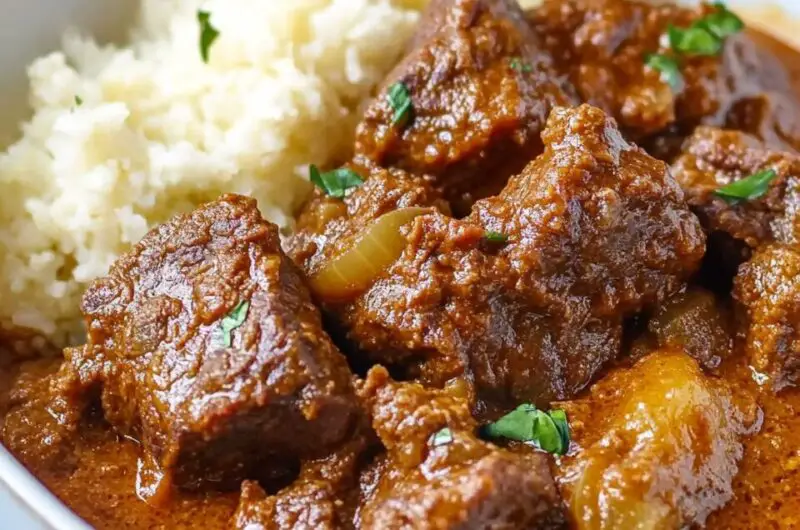Mafé (or Maafe) is a rich, savory West African peanut stew traditionally made with beef simmered in a luscious, spicy tomato-peanut sauce. Known by different names across West Africa, this Senegalese version is bold, comforting, and packed with flavor. It’s naturally gluten-free, dairy-free, and keto-friendly, especially when served with cauliflower rice. Whether you prefer it with beef, chicken, or as a vegetarian dish, Mafé is a one-pot meal that’s both nutritious and deeply satisfying.
Full Recipe:
Ingredients
-
2 lbs stew beef, cut into chunks
-
½ cup peanut butter (natural or creamy)
-
1 red bell pepper, chopped
-
2 tbsp tomato paste
-
1 onion, chopped
-
1 tbsp beef bouillon powder
-
1 tsp cayenne pepper (adjust to taste)
-
¼ cup olive oil
-
1 tsp salt (plus a pinch for browning beef)
-
1 tsp black pepper
-
1 cup water
-
2 cups stock or broth (beef, chicken, or vegetable)
Directions
1. Sauté the beef:
Heat olive oil in a large pot over medium heat. Add beef, black pepper, and a pinch of salt. Sauté until browned (about 8–10 minutes).
2. Add vegetables:
Add chopped onion and red bell pepper. Sauté for 3 minutes until softened.
3. Stir in tomato paste:
Mix in the tomato paste and cook for 5 minutes to deepen the flavor.
4. Add liquid and spices:
Pour in the water and stock, then add bouillon, cayenne, and salt. Bring to a boil and cook for another 5 minutes.
5. Add peanut butter:
Stir in the peanut butter until fully dissolved. Simmer for another 2–5 minutes, or until the stew thickens and the flavors meld.
6. Serve:
Serve hot with cauliflower rice for a low-carb option or with traditional rice or fufu for a classic African experience.
Nutrients (Per serving, serves 6)
-
Calories: 443
-
Protein: 39g
-
Fat: 29g
-
Carbohydrates: 8g
-
Fiber: 2g
-
Sugar: 3g
-
Sodium: 812mg
-
Vitamin A: 827 IU
-
Vitamin C: 27 mg
-
Iron: 3 mg
A Staple of Senegalese Cuisine
In Senegal, Mafé is more than just food—it’s a cultural centerpiece. Rooted in Mandinka and Wolof traditions, this dish often brings families together for communal meals. It’s typically served with rice, couscous, or fufu (a dough-like starch made from cassava, plantains, or yams), which soaks up the velvety, flavorful sauce. Mafé is known by many names across West Africa, and its ingredients may vary depending on local preferences, available produce, and personal taste. What remains consistent is the use of peanut butter and tomato base, which forms the signature richness of the stew.
The peanut in this dish is not merely a flavoring agent; it’s foundational. Introduced to the region through trade centuries ago, peanuts quickly became a crop of economic and culinary importance. As a result, dishes like Mafé evolved to utilize peanuts not only as a source of protein and fat but as a vehicle for slow-cooked depth of flavor.
Flavor Profile and Ingredients
The flavor of Mafé is bold and layered. It combines the umami richness of slow-cooked beef with the creamy nuttiness of peanut butter and the brightness of tomato paste and bell peppers. Spices like cayenne and black pepper add heat and complexity, while onion provides sweetness and body to the stew. The broth and bouillon enrich the base with savory depth.
The stew’s peanut base contributes a smooth texture and natural richness, making it satisfying without the need for cream or dairy. The tomato paste introduces acidity that balances the fat from the peanut butter, and the bell peppers add both sweetness and a subtle bitterness that rounds out the profile.
This version of Mafé uses accessible pantry staples, such as olive oil, beef bouillon, and stock. Natural peanut butter (or creamy, if you prefer a smoother finish) creates the perfect thick, clingy sauce. The result is a stew that’s both rustic and refined, easily customizable, and intensely comforting.
Health Benefits and Dietary Flexibility
Mafé is inherently nutritious and offers a number of health benefits. The combination of lean beef and peanut butter provides a high-protein, high-fat meal that supports satiety and energy. It’s a great source of iron, Vitamin A, and Vitamin C, especially when loaded with additional vegetables such as carrots, cabbage, or okra, which are commonly included in regional variations.
This recipe is also naturally gluten-free and dairy-free, making it ideal for those with food sensitivities. When served over cauliflower rice instead of traditional starches, it becomes a keto-friendly and low-carb option that doesn’t sacrifice any of the flavor or richness.
Because it’s made in one pot, it’s also great for those following a whole foods or clean eating plan. There are no unnecessary fillers or additives—just protein, vegetables, spices, and peanut butter.
Serving Suggestions and Pairings
Traditionally, Mafé is served with white rice or steamed couscous, both of which absorb the thick, flavorful sauce beautifully. In West Africa, it’s often paired with fufu or millet, depending on regional customs. For modern adaptations, you can serve it over cauliflower rice for a low-carb option, or even quinoa for added fiber.
To brighten the plate and add freshness, consider serving it with a side of sautéed greens, a tomato and cucumber salad, or a squeeze of lime over the top. If you prefer a spicier version, add extra cayenne or top with sliced chilies and a dollop of harissa or hot sauce.
For an authentic finish, a warm, crusty piece of flatbread or sweet plantains makes an excellent side dish that balances the savory notes of the stew with a touch of sweetness.
Tips for the Best Mafé at Home
Use stew beef or another cut that benefits from slow cooking. As it simmers, the meat will become tender and absorb the peanut-tomato flavor beautifully. Searing the beef first adds depth and helps seal in juices.
Cook the tomato paste properly. This step is essential—it reduces acidity and develops sweetness, ensuring your final sauce is well-rounded and rich.
Add the peanut butter last. Stir it in gently to prevent curdling and to achieve a creamy, velvety sauce. Let the stew simmer just enough to thicken without boiling too aggressively, which can separate the oils.
Don’t be afraid to customize. Mafé is a highly adaptable dish. Add vegetables like carrots, potatoes, or eggplant. Replace the beef with chicken thighs, lamb, or even fish for a lighter version. For a vegetarian twist, substitute chickpeas or tofu and load up on vegetables to maintain heartiness and flavor.
A One-Pot Wonder for All Seasons
Mafé is not just comforting—it’s practical. Made in one pot, it’s perfect for weeknight dinners or meal prep. It stores beautifully in the refrigerator for up to four days and tastes even better the next day as the flavors deepen. It also freezes well, making it a smart choice for batch cooking.
Whether you’re cooking for yourself or feeding a crowd, Mafé satisfies a range of tastes. It’s rich without being heavy, and its ingredients are easy to source and flexible to adapt. This makes it a great introduction to West African cuisine, especially for those unfamiliar with peanut-based stews.
Why Mafé Is a Must-Try Dish
Mafé is more than just a recipe—it’s a representation of West African warmth, resourcefulness, and culinary ingenuity. It reflects how a few humble ingredients can come together to create something luxurious and deeply flavorful. It bridges the comfort of familiar flavors like peanut butter and tomato with the excitement of global spices and traditional cooking techniques.
Its combination of creamy texture, bold taste, and nutritional richness makes it a must-try for food lovers of all types. And because it can be adapted to fit so many diets—keto, gluten-free, dairy-free, or vegetarian—it’s a meal that brings everyone to the table.
Conclusion
Mafé is a delicious, hearty stew that encapsulates the essence of West African comfort food. With its creamy peanut base, tender meat, and bold seasonings, it offers a warming, satisfying experience with every bite. Perfect as a nourishing dinner, a freezer-friendly meal prep option, or a cultural centerpiece for entertaining, Mafé invites you to explore the richness of African cuisine from your own kitchen. Whether you enjoy it with traditional rice or modern cauliflower alternatives, this one-pot dish is sure to become a staple in your cooking rotation—flavorful, comforting, and full of soul.








